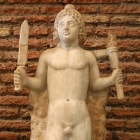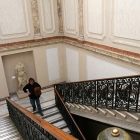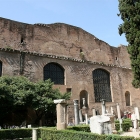Thermae Diocletiani (Diocletian’s Bath), antiquity museum of Rome
Three emperors contributed to this public bath, the most grandiose building of its type. Its 120.000 sq m size equaled the prior baths of Caracalla, but it included some architectural innovations especially about arcades and semi-domes that were to be used in churches and public buildings for the millenniums to come.
The Roman baths were something more than a relaxation or hygiene facility. Probably it included a library, places where speeches could be held and poems recited. The 3.000 people that could use the baths in a given moment would also take the occasion to socialize. The complex used other brilliant Roman inventions, such as the aqueduct, that would bring thermal or spring water from the nearby mountain. The baths typically had 3 main sections, with numerous niches and more or less private spaces: the caldarium was the innermost place, where hot baths would take place. Then followed the tepidarium, for warm baths, and finally the frigidarium, for cold baths. This was the largest room. A day at the bath might start with a sauna or hot bath and end with oiling and other treatments.
Part of the 2300 years old complex was turned by Michelangelo into a large basilica, Santa Maria Degli Angeli e dei Martiri. The amazingly high vaults of another wing of the complex now holds some relics, while the palace is occupied by the Museum of Rome. Among the exhibits, the Sarcophagus of Portonaccio, a bass-relief with battle scenes.
The inner yard of the palace is especially beautiful and also holds some antique sculptures and fragments of former basins.
One statue depicts the birth of Mithras, a god in the Zoaroastrian and later Mithraic mysteries. The followers of that cult believed he was born from a rock, as a young boy, holding a gladius (short Roman sword) in one hand and a torch in other hand, symbolizing the strength and the esoteric information of this secret initiatic cult, popular among the Roman soldiers.
- Home Page
start page - Architecture
landmark buildings - Sacred architecture
places of worship - Nature
landscape photography - Concert
performing artists - Christmas
Santa Claus pictures
- Jooble
jobs for photographers - Escape
an out of control blog - Merry Christmas
The best organizer of Christmas parties - Astro photo
Eclipse hunting and astrological photography



















